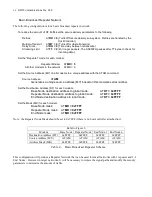
GDI Communications Inc. LLC
13
Setting up a Repeater
After all setups have been configured,
use ATWR to save the configuration to NVRAM,
&
use ATCN to Exit Command Mode
In a repeater topology there is typically one “Base Node”, one or more “Repeaters” and several “End Nodes.” A
repeater is required whenever two SS900FHs are not within Line-Of-Sight of each other or when the
distance/interference is to great.
The Repeater Network depends on setting up of the addresses of the SS900FH. The three address parameters
(MY – Source Address, DT – Destination Address, MK – Address Mask) Determine where the packet will be
routed.
Repeater topology overview
The Base Node is located at the master/local modem. It broadcasts packets to the entire network and accepts
packets from remote/repeater modems only. Depending on environmental conditions it may be necessary to have
more than one base modem.
The Repeater Node accepts packets from both Base Nodes and End Nodes and re-broadcast them. It also routes
accepted packet to an attached host/controller via it’s COM port. It also transmits any responses from it’s
attached host/controller.
The End Node routes any received packets to it’s COM port. It also transmits any responses from it’s attached
host/controller.
IMPORTANT
While the picture above depicts the use of omni directional antennas,
in practice directional antennas greatly improve network performance.
Base (MD=6)
Repeater (MD=5)
Repeater(MD=5)
End Nodes (MD=6)
End Nodes (MD=6)
Summary of Contents for SS900FH series
Page 1: ...PRELIMINARY SS900FH User Guide Preliminary GDI COMMUNICATIONS L L C SPARKS NEVADA ...
Page 2: ...PRELIMINARY ...
Page 4: ...PRELIMINARY ...
Page 6: ...GDI Communications Inc LLC PRELIMINARY ...
Page 8: ...GDI Communications Inc LLC PRELIMINARY ...
Page 10: ...GDI Communications Inc LLC ...
Page 40: ...GDI Communications Inc LLC Spectrum Display of the received data using the ATRM command ...
















































